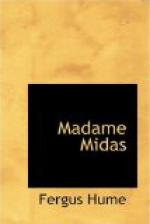Q. Was it a man’s hand or a woman’s?
A. I don’t know. It was too indistinct for me to see clearly; and I was so afraid, I fainted.
Q. You saw it pour something from a bottle into the glass on the table?
A. Yes; but I did not see it withdraw. I fainted right off.
Q. When you recovered your senses, the deceased had drank the contents of the glass?
A. Yes. She must have felt thirsty and drank it, not knowing it was poisoned. Q. How do you know it was poisoned?
A. I only suppose so. I don’t think anyone would come to a window and pour anything into a glass without some evil purpose.
The Coroner then asked why the glass with what remained of the contents had not been put in evidence, but was informed that the glass was broken.
When Kitty had ended her evidence and was stepping down, she caught the eye of Vandeloup, who was looking at her keenly. She met his gaze defiantly, and he smiled meaningly at her. At this moment, however, Kilsip bent forward and whispered something to the Coroner, whereupon Kitty was recalled.
Q. You were an actress, Miss Marchurst?
A. Yes. I was on tour with Mr Theodore Wopples for some time.
Q. Do you know a drama called ‘The Hidden Hand’?
A. Yes—I have played in it once or twice.
Q. Is there not a strong resemblance between your story of this crime and the drama?
A. Yes, it is very much the same.
Kilsip then gave his evidence, and deposed that he had examined the ground between the window, where the hand was alleged to have appeared, and the garden wall. There were no footmarks on the flower-bed under the window, which was the only place where footmarks would show, as the lawn itself was hard and dry. He also examined the wall, but could find no evidence that anyone had climbed over it, as it was defended by broken bottles, and the bushes at its foot were not crushed or disturbed in any way.
Dr Chinston was then called, and deposed that he had made a post-mortem examination of the body of the deceased. The body was that of a woman of apparently fifty or fifty-five years of age, and of medium height; the body was well nourished. There were no ulcers or other signs of disease, and no marks of violence on the body. The brain was congested and soft, and there was an abnormal amount of fluid in the spaces known as the ventricles of the brain; the lungs were gorged with dark fluid blood; the heart appeared healthy, its left side was contracted and empty, but the right was dilated and filled with dark fluid blood; the stomach was somewhat congested, and contained a little partially digested food; the intestines here and there were congested, and throughout the body the blood was dark and fluid.
Q. What then, in your opinion, was the cause of death?
A. In my opinion death resulted from serous effusion on the brain, commonly known as serous apoplexy.




